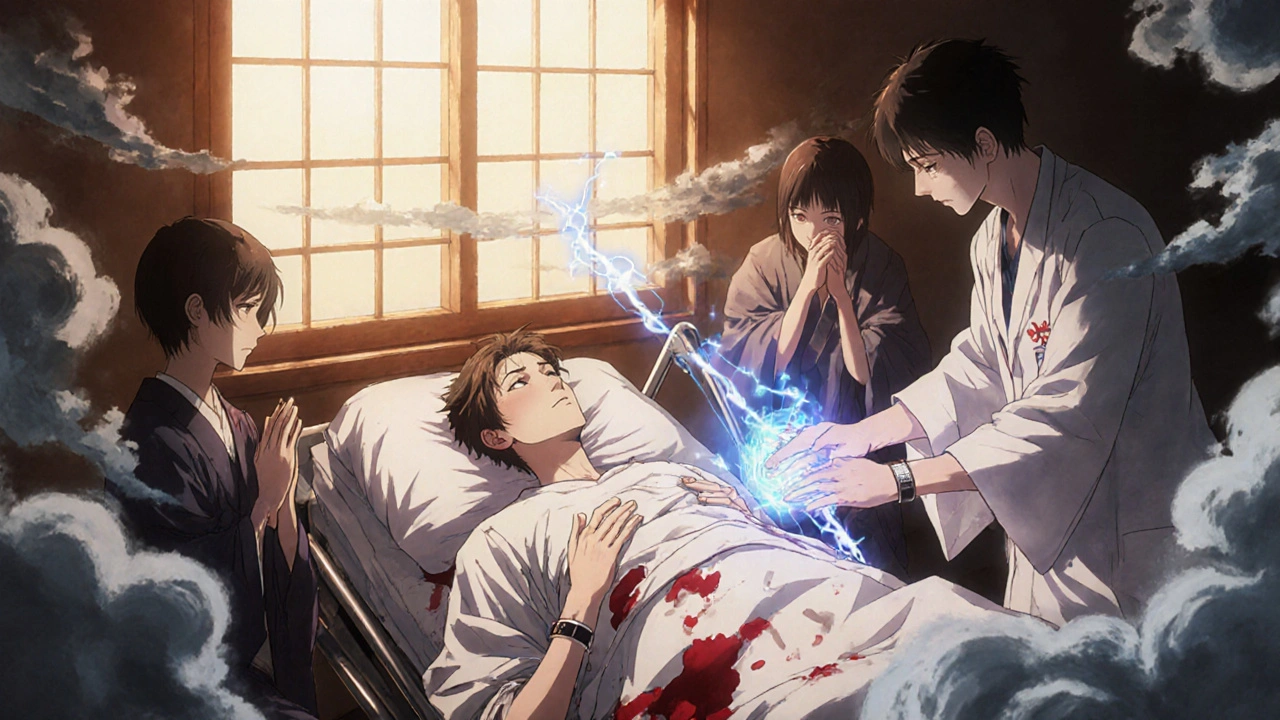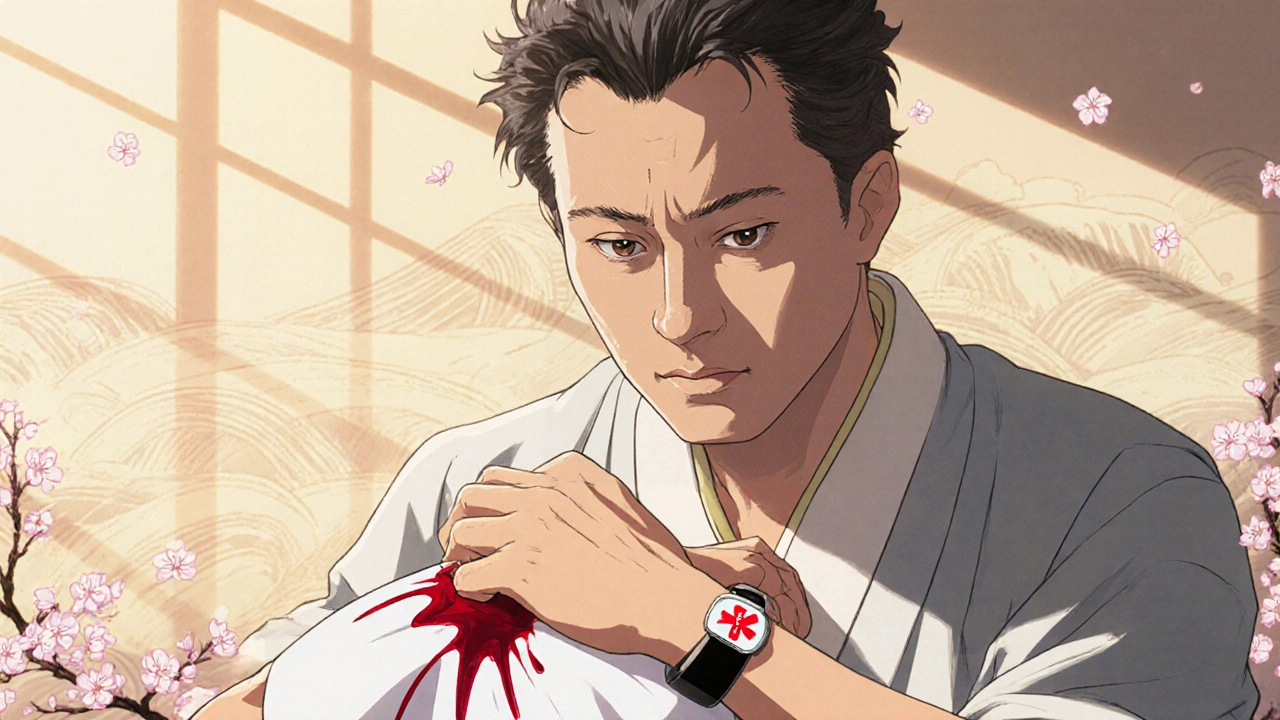Blood Thinner Bleeding Emergency Checker
Check Your Symptoms
This tool helps determine if your bleeding requires emergency care or can be managed at home. Based on medical guidelines for blood thinner users.
Remember: If you have any emergency symptoms, seek medical care immediately. Do not delay.
Do not stop your medication without consulting your doctor. Stopping can increase clotting risk by 300% within 24-48 hours.
Always call your doctor for bleeding concerns, even if symptoms seem minor. Many anticoagulation clinics offer telemedicine consultations.
Taking a blood thinner can save your life-by preventing strokes, heart attacks, or pulmonary embolisms. But it also means your body has less ability to stop bleeding. That’s a real trade-off. And when you’re on one of these medications, even a small cut or nosebleed can make you panic. The question isn’t whether you’ll bleed-it’s when to know it’s serious.
What Are Blood Thinners, Really?
Blood thinners, or anticoagulants, don’t actually thin your blood. They slow down the clotting process. Common ones include warfarin (Coumadin), apixaban (Eliquis), dabigatran (Pradaxa), rivaroxaban (Xarelto), and heparin. These are prescribed for conditions like atrial fibrillation, deep vein thrombosis, or after a pulmonary embolism. In atrial fibrillation, they cut stroke risk by 60-70%. That’s huge.
But here’s the catch: every year, about 3% of people on these drugs have a major bleeding event. For some, it’s life-threatening. The key isn’t avoiding all bleeding-it’s knowing which bleeding needs an ER visit and which you can handle at home.
When Bleeding Is an Emergency
If you’re on a blood thinner, these signs mean go to the ER now:
- Uncontrolled bleeding that doesn’t stop after 10-15 minutes of firm, continuous pressure
- Vomiting blood or coughing up blood (even if it’s just a small amount)
- Blood in your urine-bright red or dark, like cola
- Black, tarry, or sticky stools-this means bleeding in your gut
- A nosebleed that lasts longer than 30 minutes, even with pressure
- Sudden, severe headache, confusion, or loss of consciousness-could be bleeding in the brain
- Severe back or abdominal pain, especially if it comes with dizziness or low blood pressure
- Unexplained bruising the size of a palm or larger, especially if it appears without injury
- Menstrual bleeding that soaks through a pad or tampon every hour for several hours
These aren’t just "annoying" symptoms. They signal internal or massive bleeding. For example, intracranial bleeding (bleeding in the brain) happens in 0.2-0.5% of blood thinner users each year-and it kills 40-50% of those affected. Even a minor head bump can lead to this kind of bleeding, sometimes hours or days later. If you hit your head, get checked-even if you feel fine.
What Counts as "Minor" Bleeding?
Most bleeding on blood thinners isn’t an emergency. In fact, over half of all ER visits by people on anticoagulants are for things that could’ve been handled at home. This is called "nuisance bleeding." It includes:
- Nosebleeds that stop after 10-15 minutes of pinching the soft part of your nose
- Cuts that take a few minutes longer than normal to clot
- Bleeding gums when brushing
- Small bruises that fade over a week
These are frustrating, yes-but not dangerous if managed correctly. A 2023 study from Stop the Clot found that 52% of ER visits by anticoagulant users were for nuisance bleeding. And here’s the scary part: 68% of people who stopped their medication after these events had a clot within 30 days. A clot can kill faster than bleeding.

How to Handle Minor Bleeding at Home
For minor cuts or scrapes:
- Apply firm, continuous pressure with a clean cloth or gauze for at least 10 minutes. Don’t peek. Checking early resets the clock.
- Elevate the injury above your heart if possible.
- Don’t use hydrogen peroxide or alcohol-it delays healing.
- Once bleeding stops, apply a bandage. Avoid aspirin or NSAIDs like ibuprofen for pain-use acetaminophen (Tylenol) instead.
For nosebleeds:
- Sit upright and lean slightly forward. Don’t tilt your head back-that makes you swallow blood, which can upset your stomach.
- Pinch the soft part of your nose (just below the bridge) for 10-15 minutes straight.
- Use a cold pack on the bridge of your nose if it helps.
- If it’s still bleeding after 30 minutes, go to the ER.
Remember: pressure needs to be firm. It should hurt a little. If you’re just lightly pressing, it won’t work.
Why Stopping Your Medication Is Dangerous
Many people stop their blood thinner after a nosebleed or cut because they’re scared. Don’t. Stopping without medical advice is one of the riskiest things you can do.
Clotting risk spikes within 24-48 hours of missing a dose. One study showed that people who stopped their medication after minor bleeding had a 300% higher chance of a stroke or clot in the first week. Another found that 68% of those who quit had a clot within 30 days. The risk isn’t theoretical-it’s documented in real patients.
Instead of stopping, call your doctor. Most clinics have anticoagulation nurses who can guide you through minor bleeding without sending you to the ER. Telemedicine consults for bleeding concerns are growing fast-and they’re saving lives by keeping people on their meds.

New Tools Are Changing the Game
There’s good news on the horizon. In 2023, andexanet alfa (Andexxa) became available to reverse apixaban and rivaroxaban in emergencies. It cuts the time to stop bleeding from over three hours to under an hour. And by 2024, a new universal reversal agent called ciraparantag is expected to be approved-this could work on all types of blood thinners.
Emergency departments are also moving toward point-of-care testing. Soon, they’ll be able to check your clotting levels in minutes, not hours. That means faster, more targeted treatment.
But access isn’t equal. Studies show Black and Hispanic patients wait 23-28% longer for reversal agents than White patients. That delay increases death risk. If you’re in an emergency, know your medication and ask: "Can you give me a reversal agent if needed?" Be your own advocate.
What You Should Do Right Now
If you’re on a blood thinner, do these three things today:
- Write down your medication name, dose, and doctor’s contact info. Keep it in your wallet or phone.
- Know your emergency signs-print them out or save them in your notes.
- Call your doctor’s office and ask if they have an anticoagulation clinic or nurse you can call for minor bleeding questions.
You don’t need to live in fear. You just need to know what to watch for-and what to do.
Can I still exercise or play sports while on blood thinners?
Yes, but avoid high-risk activities like contact sports (football, hockey) or activities with a high fall risk (rock climbing, skiing). Walking, swimming, cycling, and light strength training are safe and encouraged. Always wear protective gear, and let your doctor know your activity level so they can adjust your care plan.
Do I need to get my blood tested regularly?
If you’re on warfarin, yes-you’ll need regular INR blood tests to make sure your dose is right. If you’re on a DOAC like Eliquis or Xarelto, routine blood tests aren’t usually needed because these drugs have predictable effects. But your doctor may still check kidney and liver function every 6-12 months.
Can I drink alcohol while on blood thinners?
Moderate alcohol is usually okay-one drink per day for women, two for men. But heavy drinking increases bleeding risk and can interfere with how your body processes warfarin. Avoid binge drinking. If you’re unsure, ask your doctor. Some people need to avoid alcohol completely, especially if they have liver problems.
What should I do if I miss a dose?
If you miss a dose, take it as soon as you remember-unless it’s close to your next scheduled dose. Never double up. For warfarin, skip the missed dose and resume your regular schedule. For DOACs like Eliquis or Xarelto, take it as soon as you remember on the same day. If it’s the next day, skip it and resume your normal dosing. Always check your specific drug’s guidelines or call your pharmacist.
Are there foods I should avoid?
If you’re on warfarin, you need to keep vitamin K intake consistent-found in leafy greens like spinach, kale, and broccoli. Sudden changes can affect your INR. DOACs like Eliquis or Xarelto aren’t affected by diet, so you don’t need to restrict foods. But avoid grapefruit juice with some blood thinners-it can interfere with how your body breaks them down.
Can I take over-the-counter painkillers?
Avoid NSAIDs like ibuprofen (Advil, Motrin) and naproxen (Aleve)-they increase bleeding risk. Acetaminophen (Tylenol) is generally safe for pain or fever. Always check with your doctor or pharmacist before taking any OTC medicine, including cold remedies or herbal supplements.
Should I wear a medical alert bracelet?
Yes. In an emergency, paramedics and ER staff need to know you’re on a blood thinner immediately. A medical alert bracelet can save your life by speeding up treatment and helping them choose the right reversal agent. It’s simple, inexpensive, and widely recommended by cardiologists and hematologists.






Just had a nosebleed that lasted 20 mins. Thought I was gonna die. Turned out fine. Still scared shitless.
I used to panic every time I scraped my knee. Now I just press down like my life depends on it-because it kinda does. Blood thinners don’t make you fragile, they just make you more aware. And honestly? That’s kinda empowering. You learn to listen to your body in a way most people never do.
Also, I keep a little card in my wallet with my med names and my doc’s number. Took me 3 near-misses to finally do it. Don’t wait like I did.
My mom’s on Xarelto and she refuses to wear a medical bracelet. Says it makes her feel like a walking medical alert. I told her if she ever gets hit by a bus, the paramedics won’t care how she feels-they’ll just want to know what’s in her veins. She still hasn’t gotten one. I’m not mad, just… disappointed.
As someone who’s been on anticoagulants for over 7 years due to AFib, I can say this article nails it. The biggest mistake I see in online forums is people thinking they can just stop their meds after a minor bleed. That’s like turning off your car’s airbag because you got a small scratch on the dashboard. The risk isn’t theoretical-it’s statistical, clinical, and terrifyingly real.
Also, I want to highlight the point about reversal agents. I was in the ER last year after a fall, and they didn’t have Andexxa on hand. Waited 90 minutes while my INR was through the roof. If you’re on a DOAC, know your reversal agent exists. Ask for it. Push for it. Your life might depend on it. And yes, I’ve seen the disparities in care too-especially in rural ERs. It’s not fair, but awareness is the first step to change.
So if I’m on Eliquis, I don’t need to count vitamin K in my kale smoothie? Thank god. I thought I had to give up my daily greens forever. Also, Tylenol over ibuprofen-got it. I always assumed ‘painkiller’ meant ‘safe.’ Nope. Learned that the hard way.
Actually, the 3% major bleeding statistic is misleading. It’s an aggregate. For patients over 80 with renal impairment, the risk jumps to 8-12%. And the article doesn’t mention that DOACs have higher GI bleeding risk than warfarin in elderly patients. Also, the 68% clot rate after stopping meds? That’s from a single 2023 cohort study with selection bias. Real-world data shows closer to 50%. Don’t treat every number like gospel.
Let’s be honest: the entire premise of this article is built on the assumption that patients are rational, literate, and have access to consistent healthcare. What about the 30% of Americans who can’t afford a $50 co-pay? What about the undocumented immigrant who fears the ER? What about the person who doesn’t know what ‘INR’ means? The article reads like a pamphlet from a pharmaceutical marketing team. It’s well-written, yes-but it’s written for the privileged. The rest of us? We just pray we don’t bleed out before our next appointment.
Blood thinners are like carrying a grenade with a pull tab labeled ‘DO NOT REMOVE.’ You don’t live in fear-you live with awareness. Every bruise, every nosebleed, every skipped dose-it’s not weakness, it’s vigilance. And that’s not a burden. It’s a quiet kind of strength. You learn to respect your body not because it’s perfect, but because it’s fragile-and that’s beautiful.
Also, I wear my medical bracelet every day. Not because I’m scared. Because I’m grateful. I’m alive because someone, somewhere, figured out how to slow the clot. I owe it to that science to be smart about it.
So… we’re supposed to just accept that we’re one stumble away from a brain bleed? Cool. I’ll just carry a first aid kit and a printed copy of this article. And maybe a backup plan in case the ER is closed, the reversal agent is out of stock, and my doctor’s on vacation. All standard stuff.
Meanwhile, I’ll be over here, quietly wondering why we’re not developing better clotting tech instead of teaching people how to bleed more carefully.
Let’s not romanticize this. Blood thinners are a band-aid on a ruptured aorta. They reduce stroke risk, sure-but they turn your body into a ticking time bomb with a 3% annual chance of catastrophic failure. And the ‘minor bleeding’ you’re told to ignore? It’s often the precursor to the big one. You think a bruise the size of a palm is harmless? Try having your spleen rupture because you ‘didn’t think it was serious.’
Also, the article ignores the elephant in the room: we’re overprescribing these drugs. Atrial fibrillation in elderly patients? Often overdiagnosed. The real solution isn’t better reversal agents-it’s better diagnostics and fewer prescriptions. But that doesn’t sell pills.
Just took my Eliquis. Woke up with a tiny bruise on my arm. Took a deep breath. Didn’t panic. Didn’t stop the med. Just kept going. This stuff works because we do.